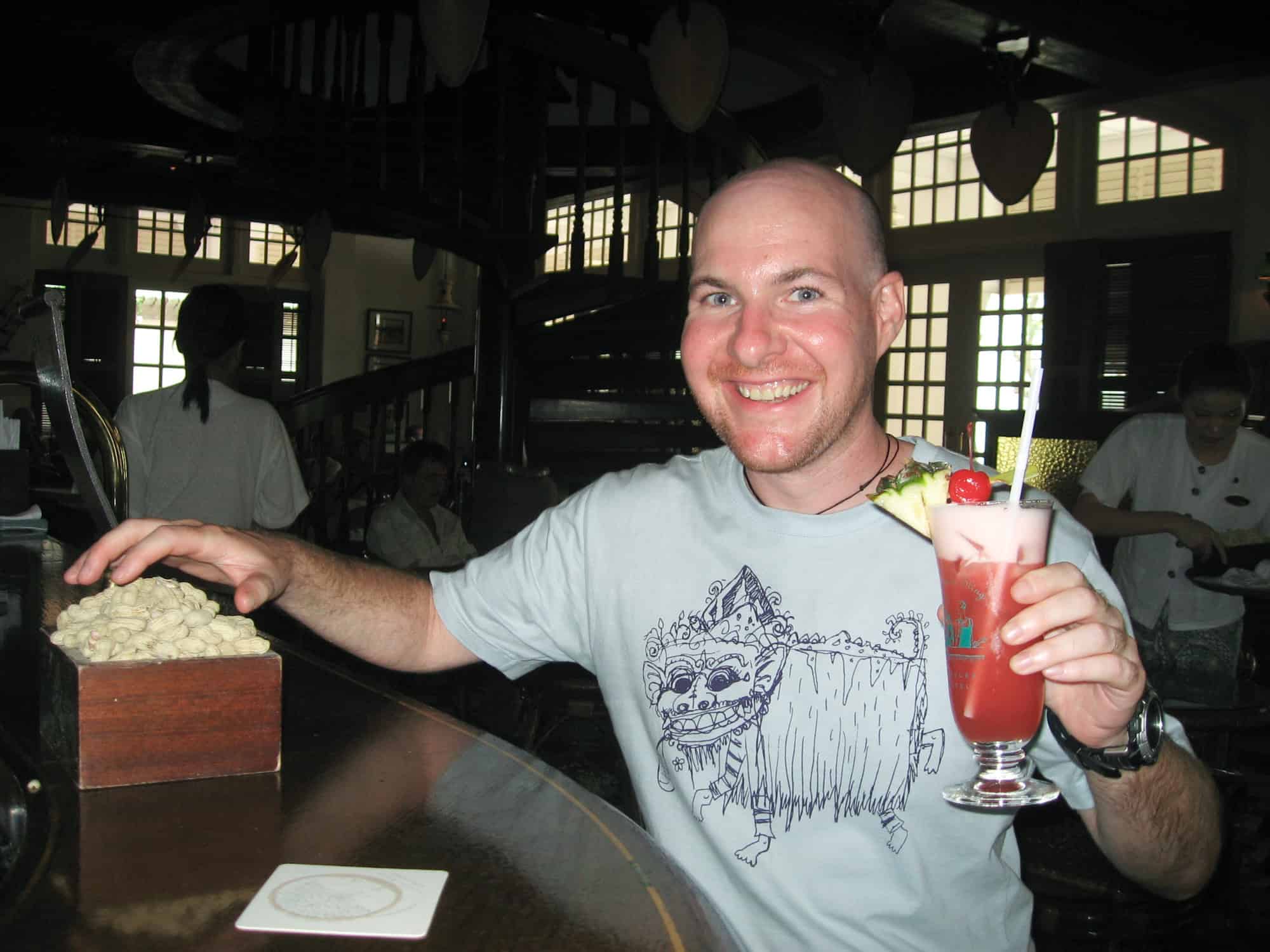
Last Friday morning, I awoke to the tragic news that Anthony Bourdain, one of my personal hero's, had taken his life at a hotel in France. He was 61.
Bourdain was there shooting an episode for his CNN series, Parts Unknown, with best friend and French chef Eric Ripert of New York's famed Le Bernardin.
Ironically, while checking my friend Mark Wiens' Instagram account, I first caught wind of what happened.
Mark had announced he was back in Ethiopia, with his signature enthusiasm, and I had stopped to comment as it's a country I've wanted to visit since my twenties.
It was in the comments I saw someone mention Bourdain.
I opened Twitter to see his name trending for the worst possible reason, suicide.
A Cook's Tour: The Coolest Show on The Food Network
In the early 2000s, having graduated from college and a requisite Ramen noodle eating phase of early bachelor living, I began tuning into The Food Network.
The upstart cable channel featured now-familiar names, including Emeril Lagasse, Bobby Flay, and Mario Batali.
It was also how the world was introduced to Anthony Bourdain, the TV host when his show A Cook's Tour aired for two seasons from 2002-2003.
Unlike the other hosts, whose shows were shot in studio kitchens, A Cook's Tour saw Bourdain traveling the world, eating exotic foods. As far as I know, it was the first TV show of its kind.
Who was this tall, lanky, wise-ass from New York City eating the still-beating heart of a cobra in Vietnam in one episode (15:40 in the video above), then dining at the Michelin-starred French Laundry in Napa Valley in another?
I had to know. I bought Kitchen Confidential, his breakout book that takes readers behind the scenes of the NYC restaurant world.
It was an exciting story that clarified how much demanding work chefs put into cooking for their customers.
I read A Cook's Tour, too. Between those books and his first show, he singlehandedly made cooking and trying new foods cool to me.
I was inspired enough to spend $100 on a chef's knife but not so inspired as to switch careers.
I was already passionate about travel, having spent a summer backpacking in Europe after college.
Four years later, in March 2002, I'd set the larger goal to quit my job and travel around the world for a year or more.
However, I had grown up a picky eater and carried my distaste for vegetables and unknown foods into early adulthood.
When I read Bourdain's writing and saw him eating crazy foods in faraway places, my attitude began to change.
I wanted to challenge myself in similar ways.
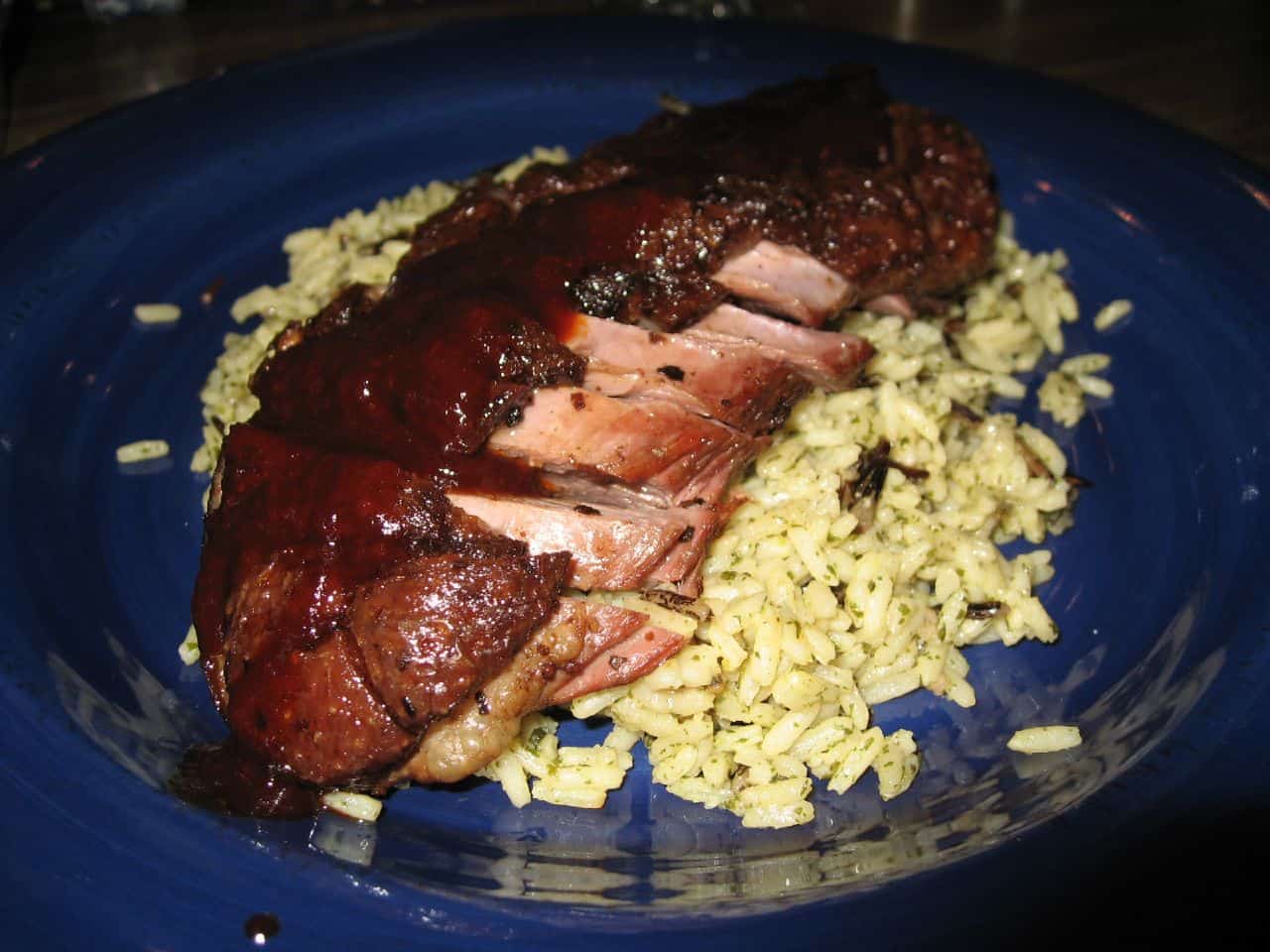
In the meantime, I began spending Saturday afternoons cooking in my tiny apartment kitchen in northern Virginia.
Primarily for myself, however, on a few occasions, for my parents too.
I could spend a whole afternoon shopping and recreating a cover recipe from an issue of Gourmet Magazine, such as the shrimp with avocado and tamarind sauce I made in October 2005.
I didn't know what tamarind was then and can still recall hunting for it in the supermarket.
Discovering new ingredients became part of the fun. Even then, I'd use the camera on my flip phone to snap a grainy, low-fi photo of the result.
Unfortunately, it's hard to find A Cook's Tour to watch online today, though some episodes have unofficially been made available on YouTube here and here. A used DVD box set is available on Amazon for $44.
Bourdain wasn't afraid to criticize The Food Network, so it was of little surprise that he jumped to The Travel Channel in the mid-2000s, taking loyal viewers like me with him.
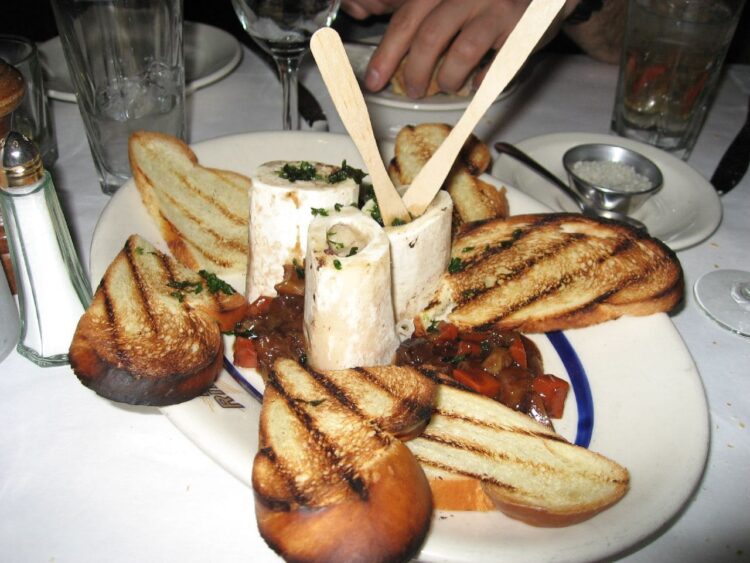
Anthony Bourdain: No Reservations
No Reservations did for The Travel Channel what A Cook's Tour did for The Food Network. It made the channel worth watching.
As the storytelling and production quality improved, No Reservations became the hallmark show of The Travel Channel, and his fame exploded.
He built a global fan base one country at a time, endearing himself with the locals by highlighting what they ate and drank, and often, the challenges their countries faced.
He always had an opinion, and I respected that he wasn't afraid to use his growing platform to get political.
Most recently, he'd become a vocal supporter of the #metoo movement.
His values often aligned with my own, strengthening the connection I felt toward him.
I watched the first few years of No Reservations religiously. I loved his storytelling, style, and self-deprecating humor.
In April 2007, seven months before quitting my job to travel, I tried a Bourdain favorite, bone marrow, late one night at Blue Ribbon, a favorite hangout for NYC chefs I'd learned about from him.
Ten years later, I celebrated my 41st birthday in NYC with dinner at Uncle Boons, a Michelin-star Thai restaurant.
The menu featured an appetizer called Kaduuk, roasted bone marrow satay with peanut sauce, toast, pickled cucumber, and onion. Naturally, we ordered it.
Following in Bourdain's Footsteps
By November 2007, I'd saved enough money to embark on my global adventure.
I resigned from my job, sold my belongings, and flew to the South Pacific.
Tahiti, French Polynesia
My first stop was Tahiti, which was featured three months earlier in S3E10 of No Reservations.
However, I didn't have the chance to visit anywhere specific from the show.
Bali, Indonesia
In February 2008, I arrived in Bali, Indonesia (S2E12 of No Reservations).
I sought out babi guling (roast suckling pig) in Ubud at what I believed to be the same restaurant as Bourdain.
I remember enjoying the meat, but I didn't care for the hard, crunchy pork skin, unlike Bourdain.
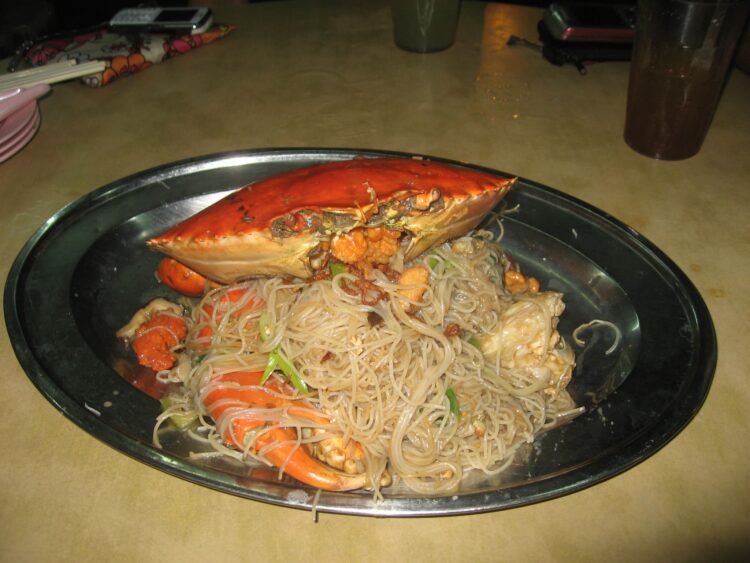
Singapore
I flew to Singapore from Bali, a city first featured on Season 2 of A Cook's Tour and later, Season 4 of No Reservations.
First, I visited the Long Bar at The Raffles Hotel, where the Singapore Sling was invented.
It was here that I realized I was seeking out experiences from a TV show for which I didn't know the cost.
In 2008, it turned out a Singapore Sling would cost me a budget-busting $18. I didn't care. I was having fun following in his footsteps.
With the help of my Couchsurfing host, I was also able to visit Sin Huat Eating House.
I ordered the crab and noodle specialty featured in A Cook's Tour (14:40 in the video above).
I hadn't eaten many crabs until that point, so it was a challenge taking it apart, let alone getting up the courage to eat the bright orange roe (guts) he savors on the show.
Again, I was so excited to be living scenes from his shows that I didn't think to ask how much the dish cost before I'd ordered it.
Sin Huat Eating House was a dive of a restaurant on the edge of the red-light district, so I was surprised to get the check and learn my crab and noodles cost $30!
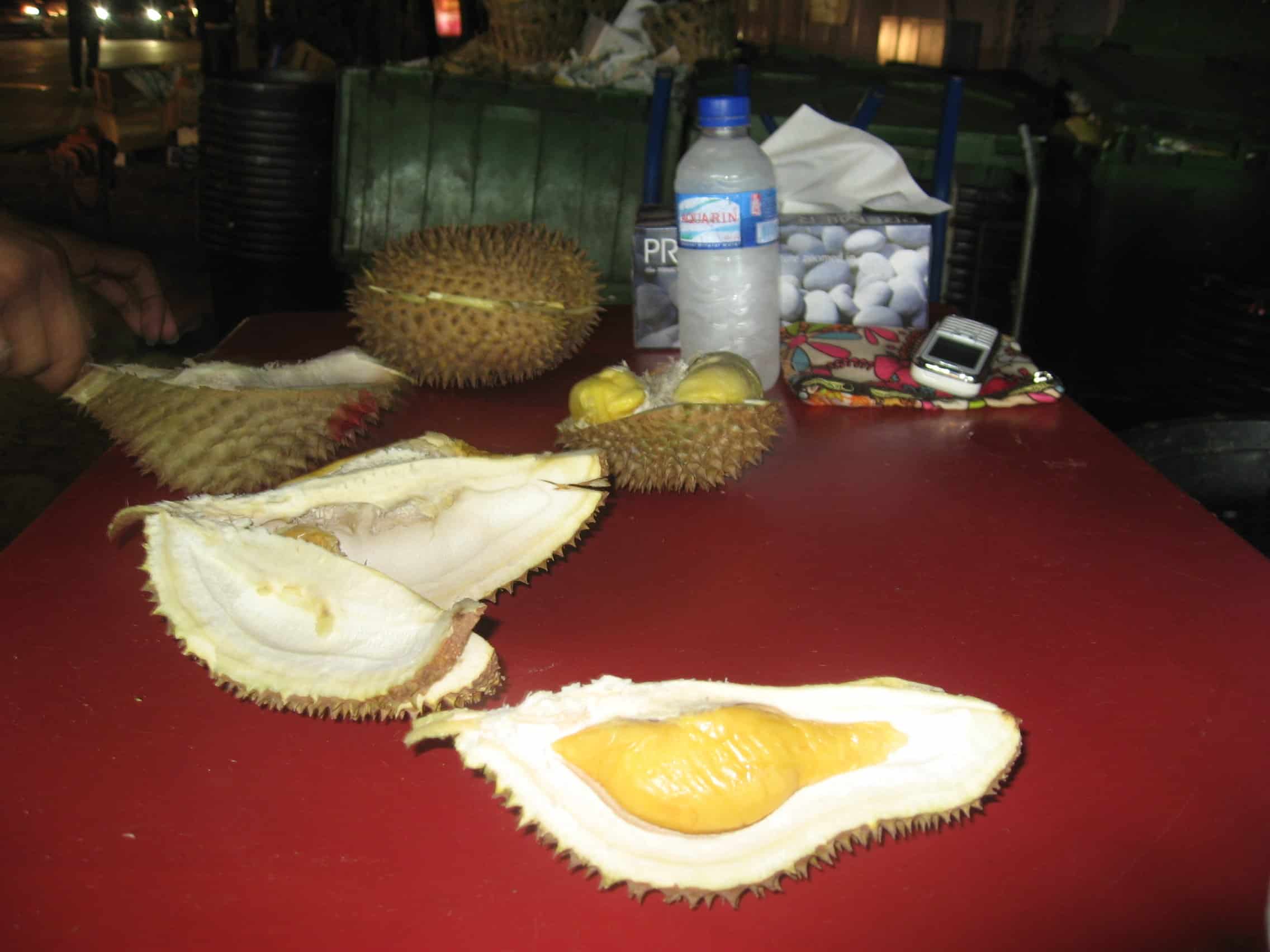
After dinner, I mentioned to my Singaporean host that I wanted to try durian, the stinky fruit I first saw Bourdain eat on S1E5 of A Cook's Tour.
Of durian, Bourdain has said, “Your breath will smell as if you'd been French-kissing your dead grandmother.”
My host walked me to a nearby durian stand and helped me buy and cut open the fruit to try.
It didn't smell as bad as I expected, and I was surprised to find I enjoyed the taste. I later had it again in Bangkok.
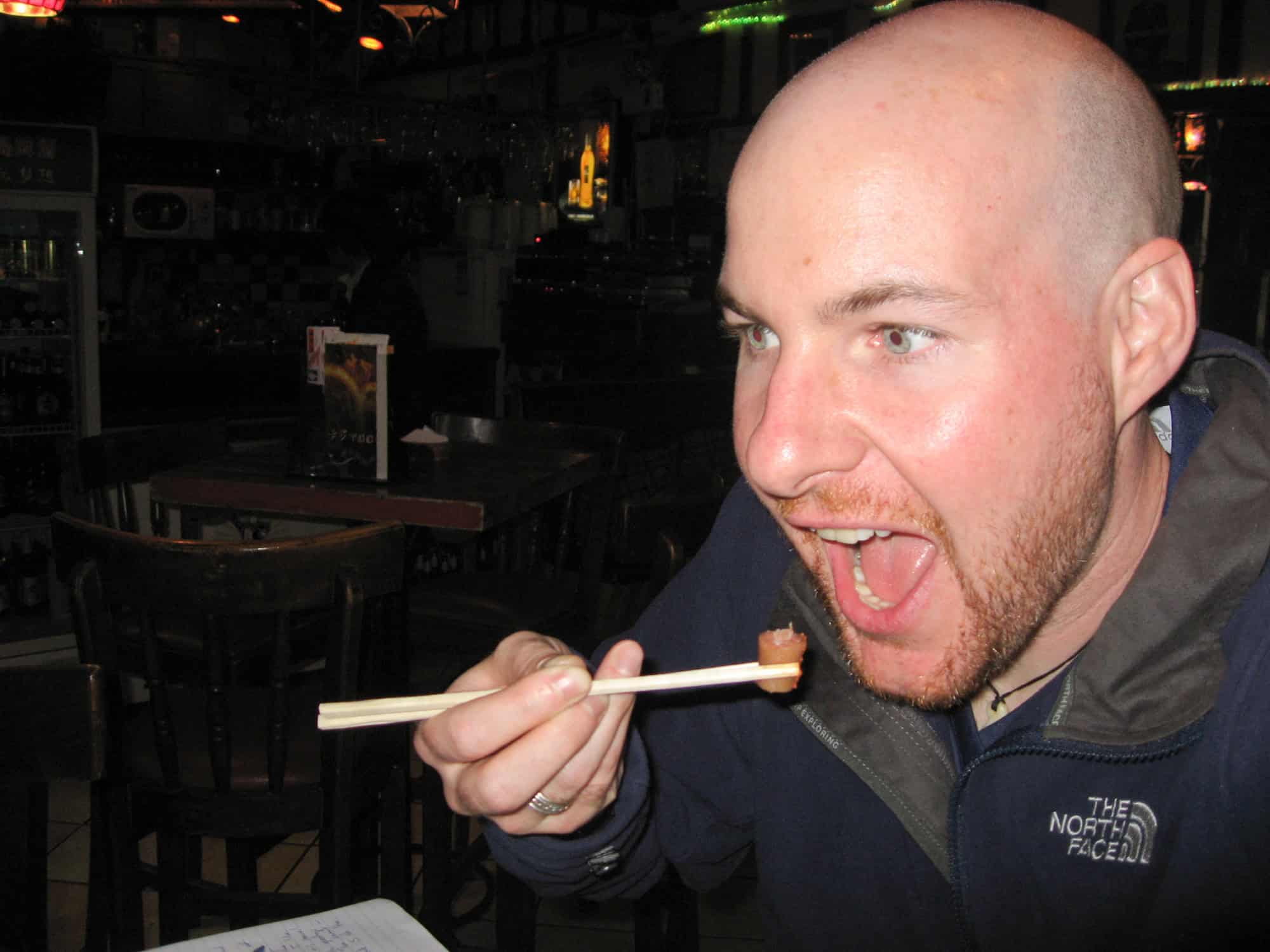
Chengdu, China
I spent a total of nine months in Asia and India in 2008, and while I lost the scent of places featured on Bourdain's shows during that time, I remained open to trying new foods, no matter how strange.
In Chengdu, China, I went out for a traditional hot-pot with my friend Charlie, and he ordered me a cow brain, which arrived raw on a plate in front of me.
I cooked the fist-sized brain in the pot of red, spicy, boiling oil at our table and then took a few bites using my chopsticks.
Of the flavor, I remember it being rather bland. It was the creamy texture that made it hard for me to eat.
I also tried chicken gizzards in another restaurant, which I didn't care for, and pig's tail, which I enjoyed with crushed red pepper.
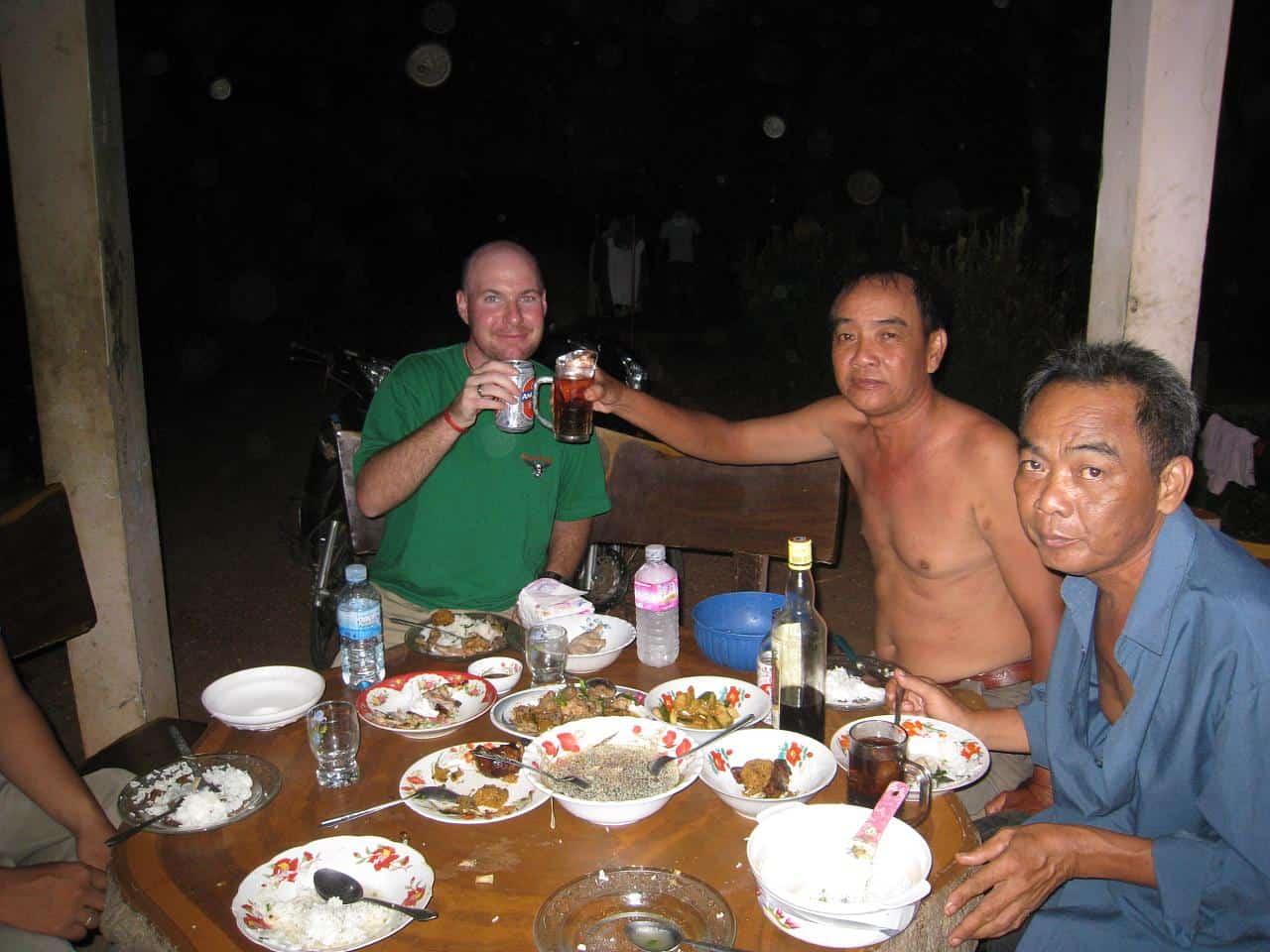
Battambang, Cambodia
I gave peanut-stuffed crickets in Cambodia a try but stopped short of the larger bugs and fried tarantulas (which Cambodians had begun eating out of necessity during the genocide).
When a Go Backpacking reader dared me to eat dog, I asked my Cambodian guide in Battambang if he knew any such restaurants.
He did, and so he took me to one for lunch. I grew up with dogs as pets and still love them, so this was a real challenge to my sensibilities, but I gave it a try. I was not too fond of it.
When that same guide invited me to eat dinner with his family, I accepted and kept an open mind about eating the curry-stuffed frogs his wife prepared.
When he asked me back the next night, his wife cooked chicken, as I'd said it was my favorite.
Being invited into the two-room home of my guide's family of ten to share traditional Cambodian food was one of the most humbling experiences of my life.
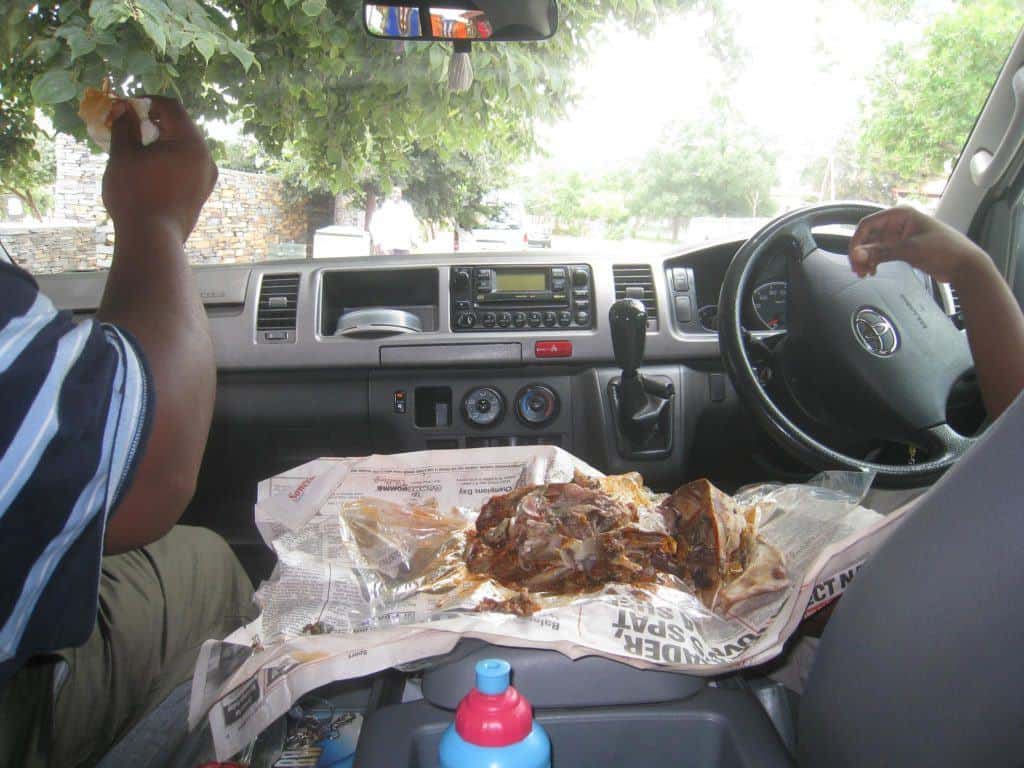
Soweto, South Africa
On a Sunday tour of Soweto, a large township near Johannesburg, I asked the guide if he knew where we could get a smiley, the nickname given to a boiled sheep's head.
He was surprised at the question and amused that I wanted to try a local favorite.
We stopped at a person's home in Soweto, where there was a line of hungry people, each awaiting their smiley.
When the guide brought mine back to the minivan, he slowly unwrapped the newspaper and plastic wrap to reveal a cooked sheep's head covered in red sauce.
He offered me an eye, his favorite part, he said; however, it was too far beyond my comfort zone, and so I left that part to him.
Instead, I got my second taste of brain and my first of tongue. A truly Bourdain moment.
Arcachon, France
Earlier in my two-month overland journey through South Africa, I met a young French couple from Bordeaux, Magali and Sebastian, at an eco-hostel on the Wild Coast.
They invited me to stay with them if I made it up there, which I vowed to do.
Several months later, on my first day in Bordeaux, we went wine tasting in Saint-Emilion.
On my second day, Sebastien took me to the nearby beach town of Arcachon, known for having the largest dune in Europe.
It was atop that 104-meter mountain of sand, with its panoramic views of the bay and pine trees, that I began to recall scenes from A Cook's Tour.
Season 1, Episode 9, to be exact. It was December 2008, so the town was empty. However, there was a small oyster shop that was open.
Curious, we walked over and ordered a half-dozen oysters and some white wine to wash them down.
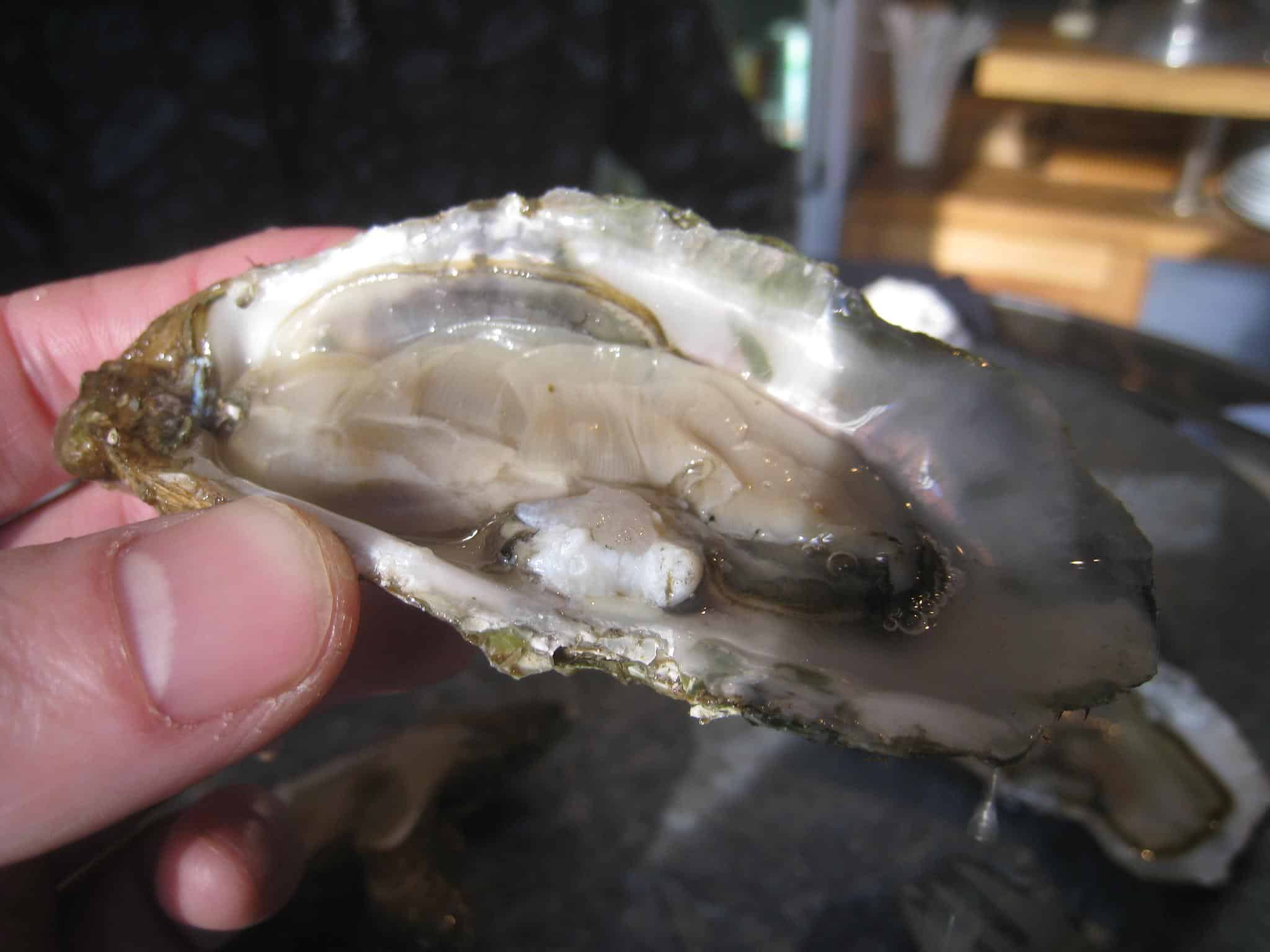
I had tried oysters in northern Virginia before but have not been a fan nor understood their appeal.
However, if there was a place to keep an open mind and give them another try, it was a French seaside town known for oyster farming.
I squirted a splash of lemon on one and slurped it down. It was delicious, like tasting the ocean.
The three-year-old oyster's freshness and the added flavor of the saltwater, not to mention the setting, left a lasting impression.
I added oysters to the growing list of foods I never thought I'd enjoy.
We then drove around the bay toward Cape Ferret, stopping to take pictures of the oyster farms.
At La Pointe, we parked the car and walked to the beach, which featured heavily-graffitied concrete WWII battlements (which I had to climb on like a kid, of course).
I felt the connection to Bourdain grow, as I remembered him climbing on the same WWII structures with his brother as he relived his childhood memories for A Cook's Tour.
Not surprisingly, tasting his first oyster as a child in Arcachon was a defining moment in his life.
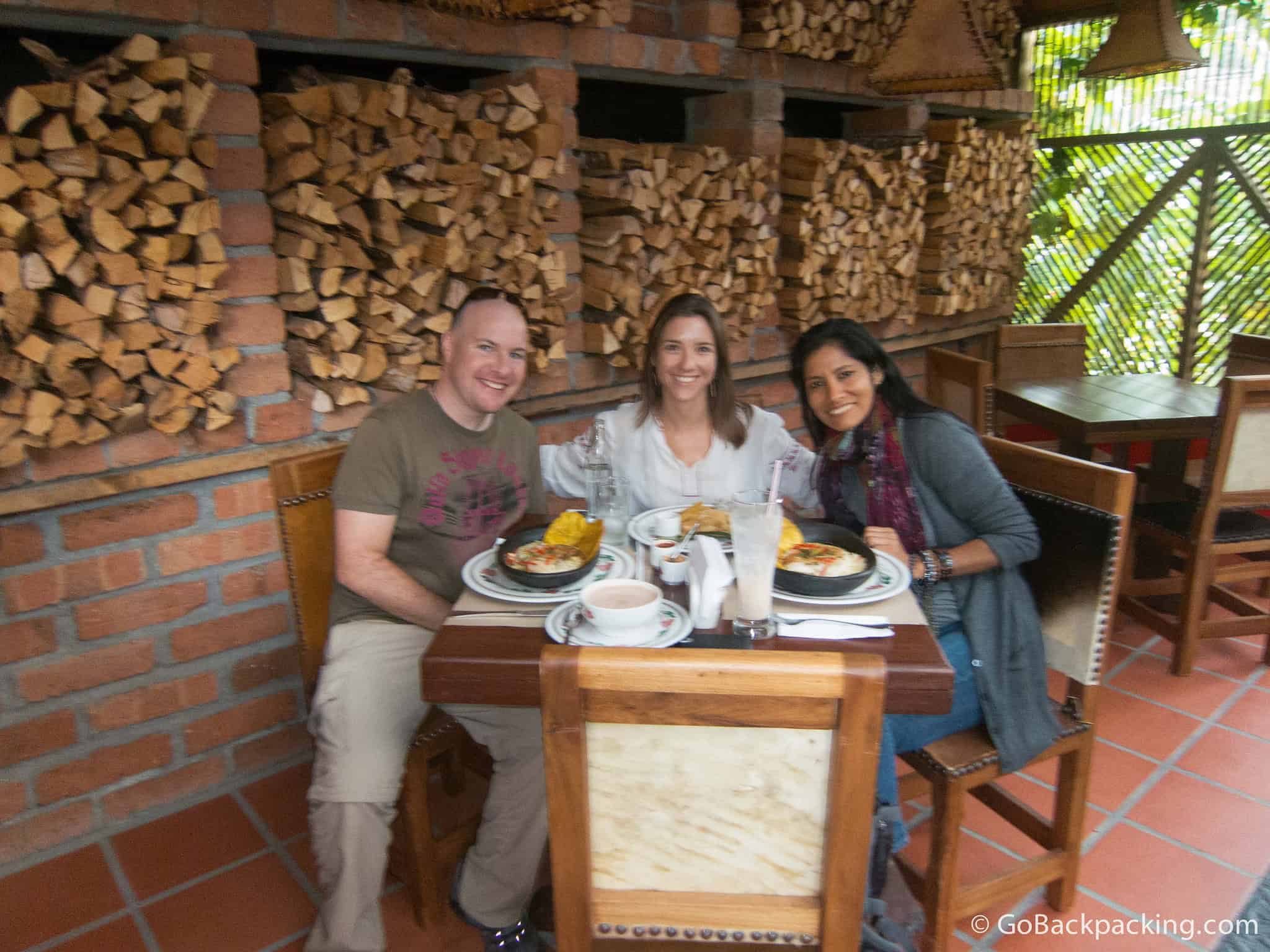
Medellin and Cartagena, Colombia
Bourdain beat me to Colombia by at least a half-year when he featured Medellin and Cartagena on S4E12 of No Reservations, which aired July 14, 2008.
It was already my plan to go, and knowing he'd had such a good experience only served to excite me more. It was like foreshadowing for my experience.
Of course, I fell in love with Medellin at first sight and walked through Botero Plaza on day one as he had on the show.
I also ate at the small, casual Brasarepa restaurant in Envigado, where they filmed a segment talking about Pablo Escobar's impact on Colombian society.
Four years later, I ate lunch with a blog reader at Quearepaenamorarte, a more upscale restaurant featured in the episode.
And in Cartagena, I've twice eaten at La Cevicheria, which was also featured in the episode.
Beyond the show, Tony talked highly of Colombia in interviews, and he returned there on S1E3 of Parts Unknown to share how the situation with the FARC and civil was changing for the better.
Final Thoughts
I could keep going with the anecdotes—the many ways in which I channeled Bourdain's excitement and appreciation for food into my own experiences.
But I think you get the picture.
He inspired me to live a richer, fuller, tastier life, and I'll be forever grateful for his work and influence.
I'm sad and hurt he's gone. Too soon. We've lost an authentic voice, one that cannot be replaced.
___
Please, if you're reading this and feel like you've lost hope for your life, seek help. In the US, call the National Suicide Prevention Lifeline at 1-800-273-8255.
Dave is the Founder and Editor in Chief of Go Backpacking and Feastio. He's been to 66 countries and lived in Colombia and Peru. Read the full story of how he became a travel blogger.
Planning a trip? Go Backpacking recommends:
- G Adventures for small group tours.
- Hostelworld for booking hostels.

Juan Ovalle
Monday 27th of August 2018
I was just rewatching some episodes of Anthony Bourdain. How he presents each city is unlike any travel show. It's truly a loss
Dave
Wednesday 29th of August 2018
I've been re-watching Parts Unknown, and just finished reading his book Medium Raw. At the least, we've got a huge body of work which can still be enjoyed.
Philip
Tuesday 12th of June 2018
A fitting tribute Dave. A couple days ago I was re-reading the story he wrote in the New Yorker way back in 1999, that launched his second culinary career. It reminded me of some kitchens I used to work as well as deepening my sense of loss and appreciation for the man.